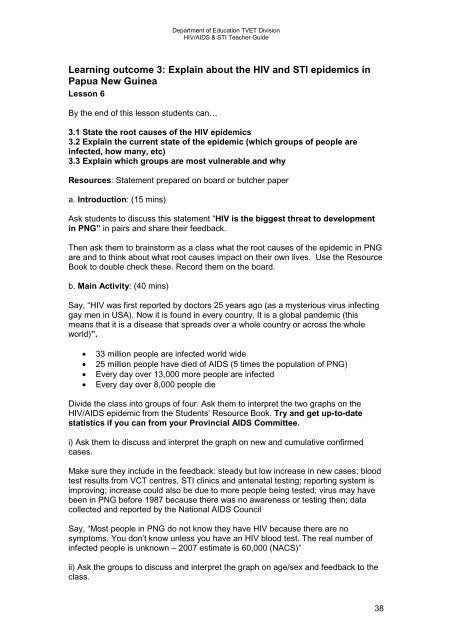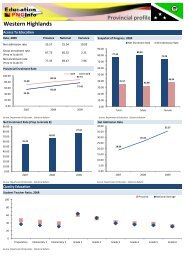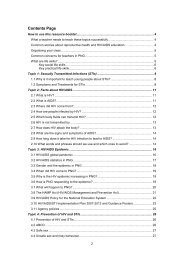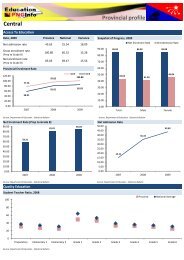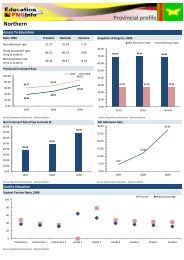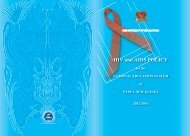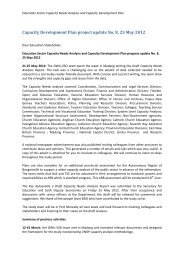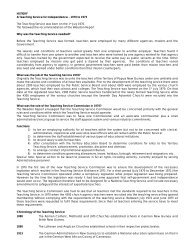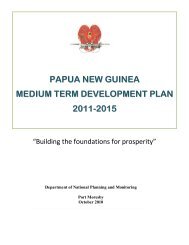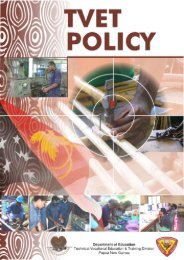Health Education to Prevent HIV/AIDS & STIs - Department of ...
Health Education to Prevent HIV/AIDS & STIs - Department of ...
Health Education to Prevent HIV/AIDS & STIs - Department of ...
Create successful ePaper yourself
Turn your PDF publications into a flip-book with our unique Google optimized e-Paper software.
<strong>Department</strong> <strong>of</strong> <strong>Education</strong> TVET Division<br />
<strong>HIV</strong>/<strong>AIDS</strong> & STI Teacher Guide<br />
Learning outcome 3: Explain about the <strong>HIV</strong> and STI epidemics in<br />
Papua New Guinea<br />
Lesson 6<br />
By the end <strong>of</strong> this lesson students can…<br />
3.1 State the root causes <strong>of</strong> the <strong>HIV</strong> epidemics<br />
3.2 Explain the current state <strong>of</strong> the epidemic (which groups <strong>of</strong> people are<br />
infected, how many, etc)<br />
3.3 Explain which groups are most vulnerable and why<br />
Resources: Statement prepared on board or butcher paper<br />
a. Introduction: (15 mins)<br />
Ask students <strong>to</strong> discuss this statement “<strong>HIV</strong> is the biggest threat <strong>to</strong> development<br />
in PNG” in pairs and share their feedback.<br />
Then ask them <strong>to</strong> brains<strong>to</strong>rm as a class what the root causes <strong>of</strong> the epidemic in PNG<br />
are and <strong>to</strong> think about what root causes impact on their own lives. Use the Resource<br />
Book <strong>to</strong> double check these. Record them on the board.<br />
b. Main Activity: (40 mins)<br />
Say, “<strong>HIV</strong> was first reported by doc<strong>to</strong>rs 25 years ago (as a mysterious virus infecting<br />
gay men in USA). Now it is found in every country. It is a global pandemic (this<br />
means that it is a disease that spreads over a whole country or across the whole<br />
world)”.<br />
• 33 million people are infected world wide<br />
• 25 million people have died <strong>of</strong> <strong>AIDS</strong> (5 times the population <strong>of</strong> PNG)<br />
• Every day over 13,000 more people are infected<br />
• Every day over 8,000 people die<br />
Divide the class in<strong>to</strong> groups <strong>of</strong> four. Ask them <strong>to</strong> interpret the two graphs on the<br />
<strong>HIV</strong>/<strong>AIDS</strong> epidemic from the Students’ Resource Book. Try and get up-<strong>to</strong>-date<br />
statistics if you can from your Provincial <strong>AIDS</strong> Committee.<br />
i) Ask them <strong>to</strong> discuss and interpret the graph on new and cumulative confirmed<br />
cases.<br />
Make sure they include in the feedback: steady but low increase in new cases; blood<br />
test results from VCT centres, STI clinics and antenatal testing; reporting system is<br />
improving; increase could also be due <strong>to</strong> more people being tested; virus may have<br />
been in PNG before 1987 because there was no awareness or testing then; data<br />
collected and reported by the National <strong>AIDS</strong> Council<br />
Say, “Most people in PNG do not know they have <strong>HIV</strong> because there are no<br />
symp<strong>to</strong>ms. You don’t know unless you have an <strong>HIV</strong> blood test. The real number <strong>of</strong><br />
infected people is unknown – 2007 estimate is 60,000 (NACS)”<br />
ii) Ask the groups <strong>to</strong> discuss and interpret the graph on age/sex and feedback <strong>to</strong> the<br />
class.<br />
38


